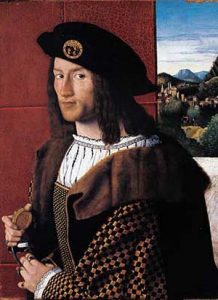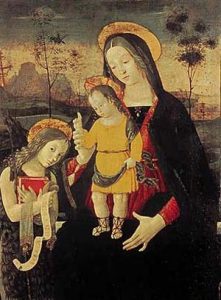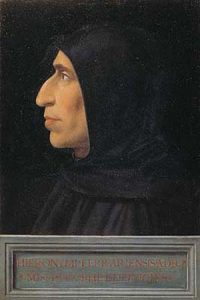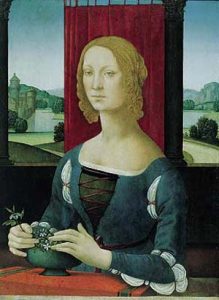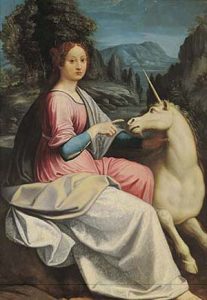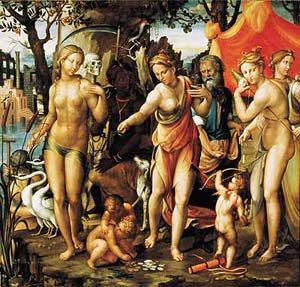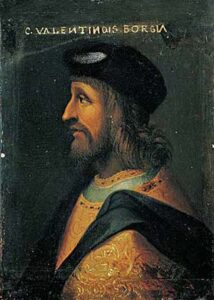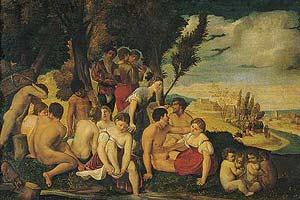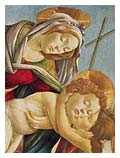The Borgias _ The art of power
Organized in collaboration with the Generalitat Valenciana, a grandiose cultural initiative on one of the most controversial families in history that marked the Italian and European events of the XVI century.
October 03 2002 / February 23 2003
Roma – Palazzo Ruspoli (131.188 visitors)
Catalogue – Electa
- Bartolomeo Veneto Ritratto di gentiluomo
- Bernardino di Betto, detto Il Pinturicchio Madonna col bambino e san Giovannino
- Fra Bartolomeo (Bartolomeo, detto Baccio, della Porta) Ritratto di fra GIrolamo Savonarola
- Lorenzo di Credi Ritratto di giovane donna (La Dama dei gelsomini) 1485-1490 circa
- Luca Longhi – Dama con liocorno (forse Giulia Farnese)
- Marco Bigio Le tre parche
- Ritratto di papa Alessandro VI Borgia Scuola tedesca fine del XV secolo
- Anonimo Ritratto di Cesare Borgia Iscrizione c.valentinois borgia Seconda metà del XVI secolo
- Luteri Giovanni di Niccolò detto Dosso Dossi Baccanale
- Sandro Botticelli Madonna col Bambino che abbraccia san Giovannino 1495-1500 circa
The exhibition on the Borgias is a cultural initiative of great scope that transcends the mere historical-biographical aspect, even though laden with interest and attractiveness, of one of the great families that shaped the Italian and European events of the 16th century.
Men and events that guided Europe towards the Renaissance, from the Europe of late medieval cities to the Europe of nation-states, pass around the world of the Borgias, almost like a crossroads of history.
Presenting the events of the Borgias in an exhibition is certainly neither easy nor simple because telling their means not only reliving the passions, dramas, and exploits of one of the most renowned and debated families of the Renaissance, but also representing the incredible intertwining of their lives and actions with an extraordinary world for the grandeur of the characters who traversed it and the events that characterized it.
When in 1492 (a date that is one of the pivotal points in Western history: the death of the Magnificent and the discovery of America), the Spanish cardinal Rodrigo Borgia became pope under the name Alexander VI, the world was experiencing one of the most intense moments of culture and human progress.
Power, luxury, and the pursuit of glory favoured the commission of new palaces, churches, monuments, furnishings, and works of art. Botticelli, Benvenuto Cellini, Michelangelo, Leonardo, Bramante, Pinturicchio, Bellini, Carpaccio, Antonello da Messina, Mantegna, Dürer, Bosch, Titian, Raphael, Ariosto, Bembo, Galileo, Copernicus, and many other great figures intertwined their lives with those of popes, princes, and kings, putting the inspiration of their genius at the service of the powerful.
The Borgias were among those powerful figures, both protagonists and certainly not passive spectators of the extraordinary changes of an era and a world. In the exhibition, the Borgias are obviously seen in the context of their time: they were creatures of their time, no worse than others, but favoured and damned by the fact that “they had the strength, therefore the right,” as the saying goes. The exhibition, held at Palazzo Ruspoli, composes in a rich and original exhibition synthesis the cultural, historical, and religious universe of the Borgia era, on which the origins of Modern Europe were founded.
The European-wide focus of the exhibition is also given by the significant contributions of promoters and organizers and the patronage of prestigious institutions, including the General Secretariat of the Council of Europe. The European dimension of the initiative is completed by numerous lending museums from Italy, Spain, Belgium, Portugal, England, France, and Austria.
Works, novels, films, and various studies have had the merit of keeping the memory of the Borgias alive until now, attracted by the undisputed charm of the dramatic events and strong personalities that characterized the lives of those figures. A merit that has been often decontextualized, leaving the Borgias suspended between history and myth.
The exhibition also aims to place those great characters in the context of history and time with a broad reconstruction that seeks to provide overall unity in historical rigor and the evocativeness of the reconstruction of a world already distant in time but so close for the timeliness of political and cultural reflections.
The exhibition on the Borgias follows a diachronic rhythm and a guiding line punctuated by the main characters of the family: Alexander, Cesare (the Valentino), and Lucrezia. It also brings together various interesting aspects of the time in which they lived and that these characters significantly characterized: culture and the arts, politics, and the economy. The exhibition achieves a contextual composition through materials and objects of special importance—borrowed for the occasion from numerous museums in Europe—capable of reconstructing the lives of those characters and the fascinating era in which they lived.

